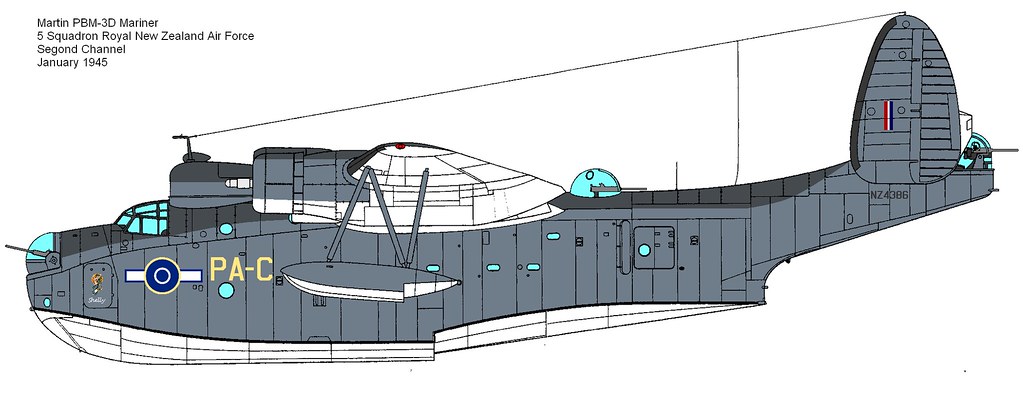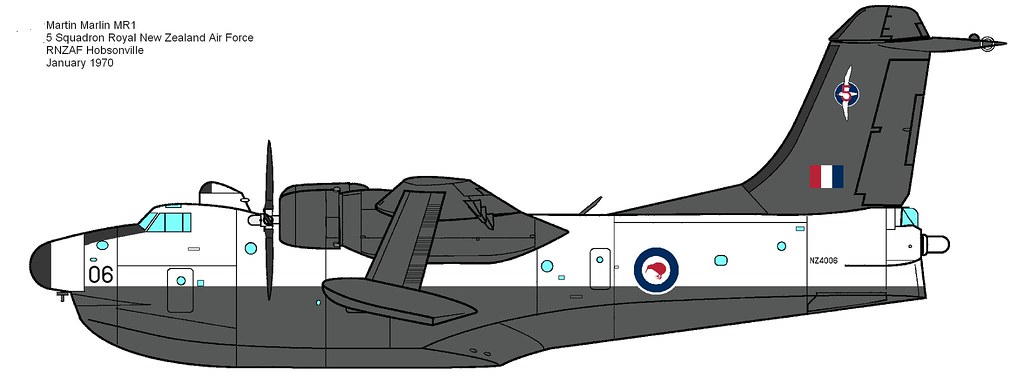At the outbreak of WW2 the RNZAF had a meagre maritime patrol force consisting of a handful of Vickers Vincent and Blackburn Baffin general reconnaissance aircraft. With the focus of the war being in Europe, this wasn’t really a problem, but the outbreak of hostilities in the Far East New Zealand found itself exposed to possible Japanese aggression. In 1941 the RAF transferred 4 aging Short Singapore flying boats to the RNZAF, which were initially deployed in Singapore, but moved to Fiji forming 5 (Flying Boat) Squadron. The RNZAF was scheduled to receive its first Catalinas in 1942, but the war in the Far East saw these diverted to the RAF and it was not until 1943 that the first Catalinas arrived, allowing the formation of 6 (Flying Boat) Squadron.
After the arrival of these first Catalinas, deliveries dried up. 5 Squadron desperately needed new aircraft, but a bottleneck in Catalina production in the USA, coupled with increased demand for the type by the USN, USAAF and RAF, meant that the RNZAF allocations were pushed further and further down the priority list.
In the end a convoluted deal was thrashed out between Wellington, Washington, and London to solve the issue. The RAF had recently decided that the Mariner GR1 flying boats it had received were not suitable for operations and they would be returned to the USN. Washington agreed that the equivalent number of PBM-3Ds would be transferred to the RNZAF from stocks in the Pacific. These were delivered to 5 Squadron in Fiji in November 1943, allowing the retirement of the last two Singapores. Training was carried out by USN personnel in situ and 5 Squadron was declared operational in February 1944 and deployed to Segond Channel, Espirito Santu for combat operations.

Through the remainder of the war, 5 Squadron flew ASW, convoy protection and SAR missions in support of Allied operations in the South West Pacific. The Mariners proved popular with the Kiwi crews, to the extent that additional aircraft were requested for long range transport operations, particularly between New Zealand and Fiji.

Five PBM-3R transports were supplied to the RNZAF in October 1944, flying missions to Suva on a weekly (and late twice weekly) basis.
At the end of the war, the RNZAF reviewed its requirements and opted to retain the Mariners and the Catalinas, all be it in reduced numbers.
Making the most of the glut of surplus aircraft available from the USN, the RNZAF returned its PBM-3Ds in exchange for twelve newly built PBM-5s, while the PBM-3Rs were returned in exchange for three PBM-5S aircraft, which were converted to transport operations.


In the meantime, 6 Squadron reduced its fleet of PBY-5s to twelve, to give a core of aircraft in the best condition and with the lowest number of hours. These were operated from early 1946 until 1949, when the USN offered to replace the PBY-5s with a similar number of PBY-6A amphibians. This offer was quickly accepted, and the exchange took place in December 1949.

Through the late 1940s and early 1950s the Mariners and Catalinas were operated on a range of missions, mainly maritime patrol operations, but also search and rescue, medical evacuations, fisheries protection and transport flights to the Chatham Islands, Fiji and Tonga.
By the mid 1950s the RNZAF began to consider replacements for both types. The search was complicated by the need to support Fiji, where no airfield big enough to operate large transports existed, so a flying boat of some sort would still be required. Various options were considered, and eventually a split type purchase was decided. 5 Squadron would be re-equipped with ten Martin P5M-2 Marlin flying boats, while 6 Squadron would receive eight Lockheed P2V-7 Neptunes. This split would allow 6 squadron to focus on ASW/MR duties, while 5 Squadron would mainly be focused on SAR and support operations, particularly to the Pacific islands without large airfields.


The new Marlins arrived in 1957, while the Neptunes followed through 1958, allowing both the Mariner and Catalina fleets to be honourably retired. To mark the important role that the PBM fleet had played in supporting the development of Fiji, one PBM-5S was donated to Fiji as a memorial and was put on display in Suva.


The two maritime types served diligently through the late 1950s and 1960s, covering thousands of miles on patrol and support operations, including numerous exercises with the RAAF, USN and USAF, as well as other allied nations.
By the late 1960s, Fiji and New Zealand had developed Nadi airport to be able to handle aircraft of virtually any size and Fiji was moving towards independence, so the requirement for the RNZAF to continue to support Fiji was rapidly reducing. This, coupled to the age of the Marlin fleet, saw the RNZAF look to make fleet changes. 5 Squadron was to relinquish its Marlins by the end of 1970, and adopt a new long range maritime patrol aircraft. 6 Squadron would relinquish its Neptunes and its maritime role, and be redeployed as a navy support squadron, taking on responsibility for maintaining the Wasp helicopters operated by the RNZN, as well as flying new HS748 transports in support of the RNZN.
To replace the Marlin and the Neptune, the RNZAF opted to follow the RAAF and adopt the Lockheed P-3 Orion, with an order for 6 aircraft, to be delivered in early 1970. Training and handover from Neptune to Orion took place throughout the year, with 5 Squadron being declared operational on the new type in November 1970, and officially retiring its last Marlin on 31 December 1970. 6 Squadron stood down on 30 November 1970, to begin its re-equipment and redeployment program.
One aircraft of each type was retained by the RNZAF, earmarked for display at the intended RNZAF Museum.

For the next 52 years the Orion would roam above the oceans around New Zealand, with upgrades and updates to keep the type competitive. Overseas deployments would see the Orions cover thousands of miles, with combat deployments to the Arabian Gulf and Timor as well. 5 Squadron would set numerous records for the number of miles and hours flown each year, as well as winning the Fincastle trophy on 8 occasions.

Like other Orion operators, the RNZAF began to look for a replacement in the Noughties. Various options were evaluated, with the final shortlist of contenders coming down to the Boeing P-8 Poseidon, Airbus A321MPA, and the Kawasaki P-1. In the end the RNZAF chose the P-1, feeling that the 4 engine configuration was safer for the long over water operations intended for the type.
Christened the P-1 Albatross in RNZAF service, 5 were ordered in 2018, with delivery of the first aircraft coming in January 2022. The second aircraft was delivered in April 2022, with the remaining three to follow by March 2023. Handover from P-3 to P-1 has begun, with the expected standdown of the P-3 to occur in June 2022.
